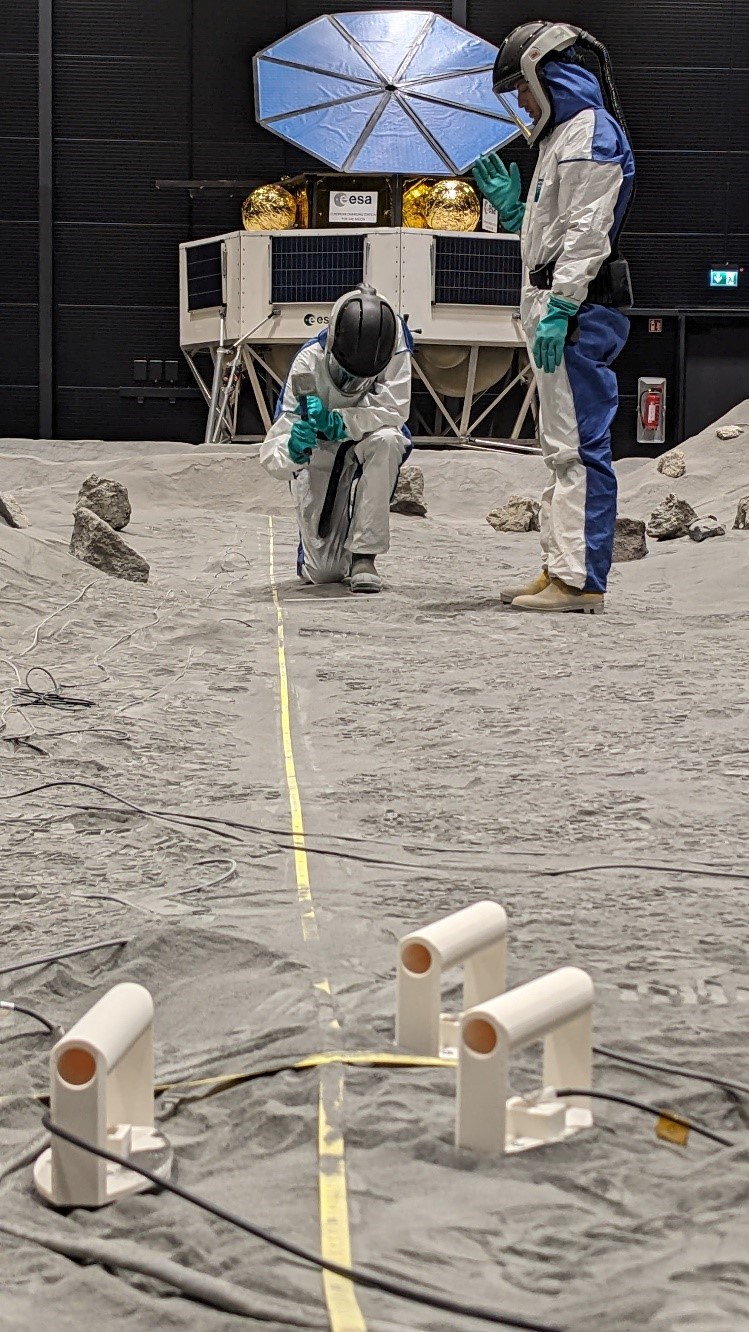First one, then two, then three and soon four: first experiments in LUNA


My A319 is taxiing across Cologne Bonn Airport in the night. The runway glows festively with its red and green lights, and ahead of us, an aircraft ascends into the starry sky. It's my last day in Cologne this year – I'm flying home for Christmas.
The day has been a whirlwind of activity, packed with impressions. It began with breakfast at 6:30 am alongside our Japanese colleagues, who were eager to see LUNA before their flight home – we managed to fit in a quick tour before 9:00 am. After that, I headed to a press conference. On the way back, I squeezed in responses to two urgent emails. Back at LUNA, I welcomed a visit from a former US astronaut who now leads a significant company. From there, I moved directly into a series of interviews, this time joined by two LUNA colleagues and Matthias Maurer. Next came a quick review of a document to ensure my colleagues could proceed with their work. The day ended with one last pre-Christmas coffee with our ground systems manager and a final meeting with my project management colleague. Now, I sit in the darkened aircraft, watching the runway lights flash past and the night stretch out beyond.
From topping-out ceremony to opening – a challenging year
My thoughts are already turning to the upcoming holidays, and then to the past twelve months – what a year it has been! In January, we were celebrating the 'topping-out' ceremony for LUNA, walking through a half-finished construction site with obligatory helmets firmly in place. In what felt like no time at all, construction was completed, the hall handed over and we found ourselves in the final push towards the grand opening in September. It was a demanding period for the entire team, both mentally and physically: daily truckloads of regolith bags to unload, assembly and equipment work to manage and the intricate coordination of various 'construction sites'. Finally, the meticulous planning for the opening ceremonies. Then came 25 September, when the world finally got to see 'our hall'.
While there's still much to do within the facility, including finalising LUNA operations and how its use by external parties will proceed, we've already managed to conduct the first scientific campaigns in what has been a truly extraordinary year.
'Full house' – the first experiments

Researchers from the ISAE-SUPAERO Institute, a French organisation, and the German Research Centre for Geosciences (GFZ) in Potsdam, were the first to work on the regolith test bed using geophones and seismometers. Together with our LUNA seismometer and the hall's fibre-optic technology, they tested how 'earthly' measuring instruments perform on a 'lunar' surface and explored ways to optimise these measurements.
Shortly afterwards, researchers from Dresden University of Technology (TU Dresden) arrived to assess whether LUNA is suitable for future ground-penetrating radar experiments. The team had previously conducted measurements before the regolith was added to the facility. This time, they focused on reference measurements in the filled hall, with particular attention on the crater in the Deep Floor Area. Using the large gantry crane, the radar system was methodically swung over the crater, collecting crucial data.
Finally, last week, our neighbours at the Institute of Communications and Navigation in Oberpfaffenhofen visited LUNA. There are no mobile phone towers or GPS signals available on the Moon. However, communication and navigation are essential for large-scale exploration of the Moon's surface. As a result, lunar exploration requires innovative methods. The institute's approach involves deploying small communication units on landers, rovers and astronaut suits, which exchange information and act as relay stations. These units create a network of many nodes that can continuously determine their relative positions via the time it takes for a signal to travel between them.
Nodes can also be placed on the surface of the Moon or distributed by rovers – and if some of them have a precisely measured position, an absolute 'position map' of all the other nodes can be created. This system could even facilitate the exploration of radio-signal dead spots, such as lava caves, by using a chain of communication nodes to maintain connectivity and simultaneously map the cave's interior.
The Microgravity User Support Center (MUSC) played a significant role in preparing and executing all these campaigns. Working alongside colleagues from the European Astronaut Centre and the German Space Operations Center in Oberpfaffenhofen, they are refining the LUNA operating concept – so every campaign provides valuable insights to validate and further develop operational processes.
Meanwhile, our Airbus is speeding down the runway. The lights of Cologne fade, eventually disappearing beneath the low cloud cover. Farewell Cologne, farewell LUNA – what an incredible year it has been! I'm looking forward to arriving home and thinking about the adventures still to come. Plans for next year's campaigns are already in motion, and my notes are full of ideas for refining the operating concept. But for now, it's Christmas. On behalf of the LUNA team, we send our warmest wishes out into the world!
Related links
Tags:
